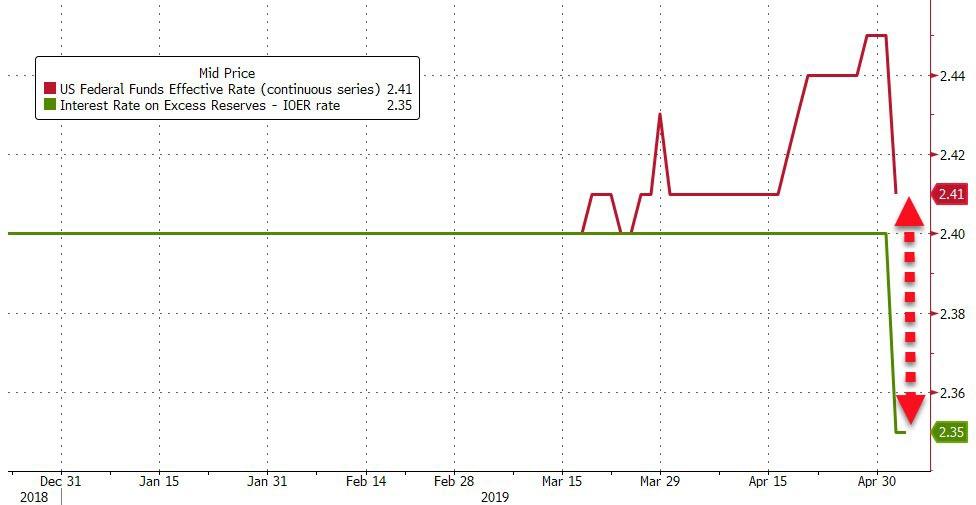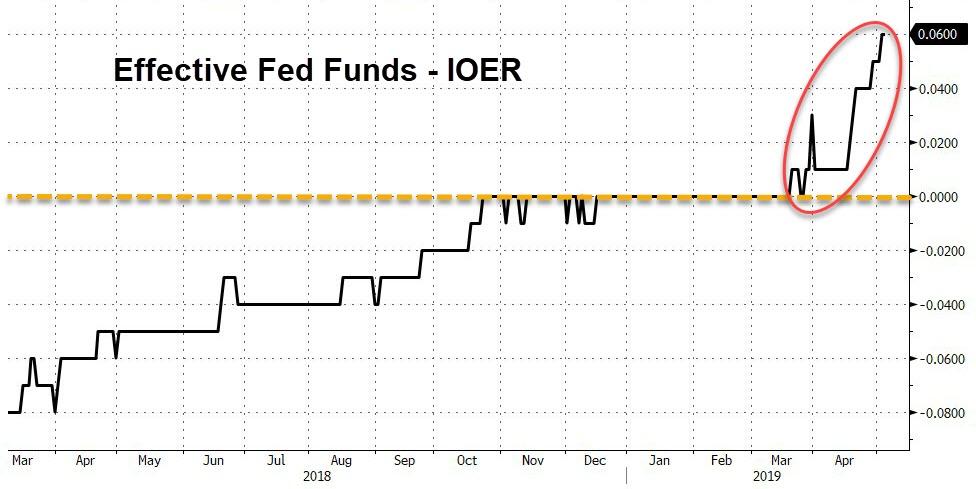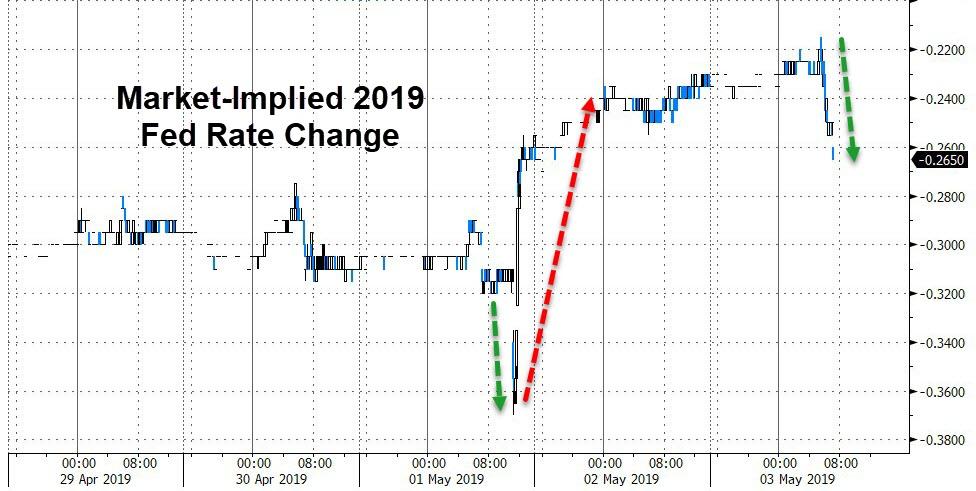The Fed Has Lost Control Of Rates As 'Technical Tweak' Fails
Tyler Durden
 While the rest of the world is distracted by the plummeting unemployment rates and trade deal hype, a funny (well not so funny) thing happened in the short-term funding markets in the world's reserve currency. While the rest of the world is distracted by the plummeting unemployment rates and trade deal hype, a funny (well not so funny) thing happened in the short-term funding markets in the world's reserve currency.
As we noted previously, something unexpected has been going on in overnight funding markets: ever since March 20, the Effective Fed Funds rate has been trading above the IOER. This is not supposed to happen.
As a reminder, ever since the financial crisis, in order to push the effective fed funds rate above zero at a time of trillions in excess reserves, the Fed was compelled to create a corridor system for the fed funds rate which was bound on the bottom and top by two specific rates controlled by the Federal Reserve: the "floor" for the corridor was the overnight reverse repurchase rate (ON-RRP) which usually coincides with the lower bound of the fed funds rate, while on top, the effective fed funds rate is bound by the rate the Fed pays on Excess Reserves (IOER), which served as the corridor "ceiling."
Or at least that's the theory. In practice, the effective FF tends to occasionally diverge from this corridor, and when it does, it prompts fears that the Fed is losing control over the most important instrument available to it: the price of money, which is set via the fed funds rate.
This week, The Fed tried to do something about it by cutting the IOER.
It has failed!
The effective fed funds rate fell to 2.41% on Thursday from 2.45%, according to New York Fed data. With the Federal Reserve’s 5bp cut to the interest on excess reserves (IOER) rate to 2.35%...

Fed effective rate on March 20 surpassed IOER for the first time since 2008, and it’s stayed above most days since.
This is a 6bps failure - worse than the 5bps spread BEFORE the Fed "tweaked".

In other words, as one veteran funding market trader exclaimed, "it's getting worse!"
Simply put, this is front and center a dollar liquidity shortage signal that The Fed is unable to solve... for now.
As Barclays' Joseph Abate recently ominously concluded:
the large move also suggests that the banking sector is "nearing the steeply sloping part of the reserve demand curve" which means that "bank reserves are now significantly closer to what individual banks consider their ‘least comfortable level of reserves’ and thus banks are more willing to pay higher rates to retain these balances."
In other words, some $1.5 trillion in excess liquidity created by the Fed is no longer enough for banks which are starting to scramble to obtain additional liquidity, which needless to say, is very troubling for a banking system which is supposedly "fortress" and "much more stable" than it was before the financial crisis. If anything, this means that even a modest liquidity draining crisis at any point in the future could have vastly more dire consequences than even the pessimists believe.
So what can the Fed do to regain control over interest rates?
According to Barclays to address the expected increase in fed funds volatility, the Fed could either end the balance sheet runoff this summer instead of waiting until September, create a standing repo facility - something which has been rumored for months - or conduct standard open market operations, injecting even more liquidity into the system.
Is Larry Kudlow right? Is The Fed preparing to cut rates, despite Powell's dismissal of directional bias? The market still thinks so...

Note, the market is shifting dovishly today despite the big beats in jobs, suggesting something else (cough liquidity cough) is affecting policy expectations.
 our mission: our mission:
to widen the scope of financial, economic and political information available to the professional investing public.
to skeptically examine and, where necessary, attack the flaccid institution that financial journalism has become.
to liberate oppressed knowledge.
to provide analysis uninhibited by political constraint.
to facilitate information's unending quest for freedom.
our method: pseudonymous speech...
Anonymity is a shield from the tyranny of the majority. it thus exemplifies the purpose behind the bill of rights, and of the first amendment in particular: to protect unpopular individuals from retaliation-- and their ideas from suppression-- at the hand of an intolerant society.
...responsibly used.
The right to remain anonymous may be abused when it shields fraudulent conduct. but political speech by its nature will sometimes have unpalatable consequences, and, in general, our society accords greater weight to the value of free speech than to the dangers of its misuse.
Though often maligned (typically by those frustrated by an inability to engage in ad hominem attacks) anonymous speech has a long and storied history in the united states. used by the likes of mark twain (aka samuel langhorne clemens) to criticize common ignorance, and perhaps most famously by alexander hamilton, james madison and john jay (aka publius) to write the federalist papers, we think ourselves in good company in using one or another nom de plume. particularly in light of an emerging trend against vocalizing public dissent in the united states, we believe in the critical importance of anonymity and its role in dissident speech. like the economist magazine, we also believe that keeping authorship anonymous moves the focus of discussion to the content of speech and away from the speaker- as it should be. we believe not only that you should be comfortable with anonymous speech in such an environment, but that you should be suspicious of any speech that isn't.
www.zerohedge.com
| 



